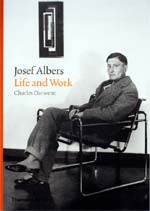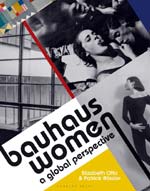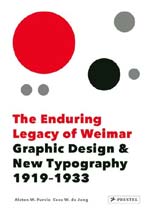
|

|
|
Home Site Search Contact Us Subscribe
|
|
Best Bauhaus Books to Peruse During the Bauhaus Centenary New publications offer invaluable biographical insights and contemporary global responses. By Norman Weinstein May 9, 2019 If the invitation from the German National Tourist Board to visit Weimar this year to celebrate the 100th anniversary of the founding of the Bauhaus you’ll decline, I would suggest that one pleasant alternative is visiting the Bauhaus as a book-laden “armchair traveler.” Publishers have greeted the Bauhaus Centenary with a wave of both new and republished volumes, and this list offers my sense of the most engaging recent publications. My biases are as follows. Biographies work best when life events and bodies of developing thinking and artistic expression interweave. Neither hagiography nor character assassination do justice to critical thought and art. Theories of possible influence linked to a School are most thoughtfully presented with generous amounts of carefully culled archival evidence. Finally, if a book isn’t fun to read, don’t feel you must because everyone who matters insists it is a masterpiece. This is particularly an issue with Bauhaus books since many that are quite loudly heralded carry the approval of prominent academics, starchitects, or New York Times reviewers. As always, sample portions online when possible.
Josef Albers: Life and Work by Charles Darwent (Thames & Hudson, $39.95). If you can read only one biography of a Bauhaus artist, this impeccably researched and carefully balanced biography is the one to savor. Rather than adhering to any conventional formulaic biographical approach, Darwent opens his study with an invitation to readers: How can Albers’ “Homages to the Square,” the series of paintings and prints comprising the centerpiece of this artist’s career, be understood through exploring key periods in the artist’s life? Themes germane to comprehending that art offer fresh insights into how Albers shaped the Bauhaus, and how he was shaped by it, during his tenure teaching there. Albers bridged daunting contradictions. The imaginatively poetic German romantic designer and inspirational teacher was also a ruthlessly competitive craftsman and hyper-critical colleague. The idealist who seemed to ascetically live solely for the sake of Art was also an unrepentant womanizer. Albers had an extraordinary life after leaving the Bauhaus, but by so specifically and painstakingly spotlighting his Bauhaus years, Darwent has written an epical tribute to both Albers and the institution he played a major role in defining.
Bauhaus Women: A Global Perspective by Elizabeth Otto & Patrick Rossler (Herbert Press, $40.00). Most Bauhaus books over the decades have showcased the men – Gropius, Albers, Moholy-Nagy – and have relegated the women to the sidelines. That sexism was in alignment with that of the institution in that Bauhaus women were often slotted into student or instructor positions in weaving workshops, a story told in Sigrid Wortmann Weltge’s out-of-print Women’s Work: Textile Art from the Bauhaus. By offering crisply concise and inviting profiles of 45 Bauhaus women, and through striking photos and graphics, Otto and Rossler celebrate the extraordinary richness of the contributions made by women in textiles as well as in supposedly “masculine” arts like architecture. Although published by an academic press, this book deserves a wide readership that should include young women seeking careers in the still male-dominant fields of architecture and design.
Are you interested in what Bauhaus architecture looks like restored? Check out the new, expanded edition of Bauhaus Architecture 1919-1933 (Prestel, $39.95) by photographer Hans Engels and writer Alex Tilch. While devoid of the dramatic shadowy artistry evident in the original Bauhaus architectural photography of Lucia Moholy (1894-1989), Engels offers a lucid and unfussy photographic journey through the buildings that now have a second-life as beguiling attractions to architecturally inclined tourists. Of particular value are the powerful images of the buildings Walter Gropius designed, a bracing corrective to the recent Gropius biography that left me wondering how he found time to start and administer the Bauhaus, teach, and have a notable architectural career while chasing every fräulein or femme fatale that crossed his path. Tilch’s text is dry but helpful in reading the photographs, and this reformulation of the original 2001 edition is welcome when visiting the restored buildings isn’t an option.
The Bauhaus influence on architecture and a variety of free and applied arts is easy to discern. But one obvious influence might be easily overlooked: its contribution to typography and graphic design. Helvetica, like a number of contemporary sans serif fonts, comes out of the Bauhaus workshops, not to mention the “Bauhaus font” itself. While the Bauhaus designers can not take all the credit for innovative sans serif fonts of the 1920s, German Dadaists and Russian Constructivists also left their mark. Alston W. Purvis and Cees W. de Jong show just how much contemporary graphic designers owe Bauhaus innovators. Look delightfully at their gloriously illustrated The Enduring Legacy of Weimar: Graphic Design & New Typography 1919-1933 (Prestel, $60.00).
All books about exciting educational experiments face the challenge of conveying the exciting atmosphere of schools where “business as usual” decorum was replaced by spontaneous outpourings of experimental artistic expression. A book that most thrillingly captures that spirit of unfettered dramatic improvisation is Bauhaus and America: Experiments in Light and Movement, by Hermann Arnhold, Kristin Bartels, and a dozen other writers (Kerber, $70.00). Focusing sharply on Bauhaus stage performances as sites for experimental multi-media presentations, the authors supplement their investigations with striking photographs of light shows that decades later would be labeled “psychedelic trips.” More substantially, the authors reveal how these Bauhaus experiments with light and motion on stage came to impact the artistry of Merce Cunningham and Robert Rauschenberg.
A sprawling compendium of how Bauhaus creativity has numerous impacts globally today, Bauhaus Imaginista, edited by Marion von Osten and Grant Watson (Thames & Hudson, $60.00), is an ideal companion to a wide variety of events worldwide in physical and virtual space during this centennial year. The editors treat the historical Bauhaus with its 14-year run as representative of a state of artistic and cultural consciousness that is as alive and influential in 2019 as it was between 1919 and 1933, or even more so. They usefully de-center the idea that Bauhaus ideas and arts were all original out-of-the-blue creations by superbly showing their Asian (Japanese and Indian) antecedents. There is a rowdy provocative rather than strictly reverential tone shared among various authors, though some might condemn Mark Wigley’s quip about Bauhaus thinking having an “anesthetic effect” on modern design by countering that various prestigious Ivy League architecture schools may have had a deeper anesthetic effect. If you think of the Bauhaus as an ever-morphing, ever-evolving spirit of design innovation, a supremely valuable question-generator, you’ll enjoy this richly illustrated and far-ranging text.
Norman Weinstein is the author of “Words That Build” – an exclusive 21-part ArchNewsNow.com series about writing as a keystone of a successful architectural practice. He's authored several books of poetry and books about music and literature. Weinstein is currently learning weaving in order to deepen his understanding of architecture, music, and poetry. He can be reached at nweinstein25@gmail.com.
More by Weinstein:
Weinstein: From Ada to Zaha and Everything In Between Op-eds, book reviews, musings, and debate.
An exclusive 21-part series that focuses on the overlooked foundations of architecture: oral and written communication.
Most recent:
Best Architecture and
Design Books of 2018
Writing About Architecture As If Only Art Matters A new coffee table book about Frederic Church's Olana combines resplendent photography with essays reflecting architectural myopia.
Welcome New Books Reveal the Heart of the Matter in Architectural Design Kenneth Frampton's new edition of Kengo Kuma's works, along with Kate Franklin and Caroline Till's global survey of novel thinking about sustainable materials, offer new slants on how materials matter.
Educating Future Architects to Think Like Curious Clients Expanding architectural education to include more about client consciousness is a key to enriching the profession.
Architectural Education at the Crossroads? Educators Duo Dickinson and Phil Bernstein look in opposite directions when assessing architecture school quality - but the next architecture school transformation may emerge from where no one is looking.
|
(click on pictures to enlarge)  Thames & Hudson "Josef Albers: Life and Work"  Herbert Press "Bauhaus Women: A Global Perspective" by Elizabeth Otto & Patrick Rossler  Prestel "Bauhaus Architecture 1919-1933" by photographer Hans Engels and writer Alex Tilch  Prestel "The Enduring Legacy of Weimar: Graphic Design & New Typography 1919-1933" by Alston W. Purvis and Cees W. de Jong  Kerber "Bauhaus and America: Experiments in Light and Movement" by Hermann Arnhold, Kristin Bartels, etc.  Thames & Hudson "Bauhaus Imaginista" edited by Marion von Osten and Grant Watson |
© 2019 ArchNewsNow.com